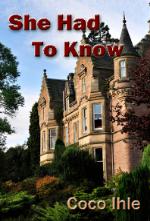I attended another fabulous Virginia Romance Writer meeting on the 8th of this month. The guest speaker was Sherry Thomas, and she talked about creating good chemistry between the hero and heroine, and about subtext. As a group exercise she had us divide into four groups, and each group had to act out the same scene with different subtexts. It was funny how differently the same scene came across, and the difference went way beyond the various settings that each group picked. One group had to express fright, and their setting was a graveyard. Another group had to convey sexual attraction, and they picked an office elevator. Another group had to portray indifference. My group was given this instruction: “the second character has to pee really badly.” In order to get that feeling of desperation across without words, we chose, as our setting, a courthouse in its first recess of the day. One lawyer tried to talk to another one about some requested papers, but the one who had to pee didn’t want to stand around and chat. The words being spoken didn’t matter nearly as much as the acting and our set design (we posted a bathroom sign, and the one who had to pee kept edging toward it).
Movies have a bit of an advantage over books. There are so many ways that a movie can convey a message—through lights, costumes, music, acting and sets. A book has only words, so how does it clearly show the same thing? According to Sherry, CONFLICT is the biggest and best subtext driver. If a conflict is set up well, then the meaning of the dialog will naturally evolve and be clear. She gave the example of one book in which the hero is really an antihero. At the beginning of the book, his difficult childhood is exposed so that the reader is able to gain sympathy for him, and better understand his later nastiness.
About good chemistry: both people need to have intellectual common ground, mutual respect, and an emotional commitment. Sherry thinks that the movie “Mr. And Mrs. Smith” perfectly shows all three, and it’s one of her favorite movies. In the beginning, Mr. and Mrs. Smith hate each other. Love develops when they—through their actions as assassins—grow to respect each other’s work.
So how do writers enhance the budding romances in their books? According to Sherry there are several things to look for:
1) Does the plot challenge strength of mind and character?
2) Do the lovers affect each other’s growth?
3) Are visuals being used to best effect? One effective technique is to describe the hero through the heroine’s eyes, or vice versa.
4) How is the pacing? Is there just the right amount of anticipation?
5) Is the heat hot enough?
6) And, most importantly, does a love scene truly move the romance along or is it there simply because the hero and heroine have been together for several chapters now, so they’d better have sex? If the later is true, skip it. Sex isn’t the key factor here. Emotion is.
Lucy Balch, author of Love Trumps Logic
Available through Amazon.com and Second Wind Publishing









